Feeding the Hyenas in Harar, Ethiopia
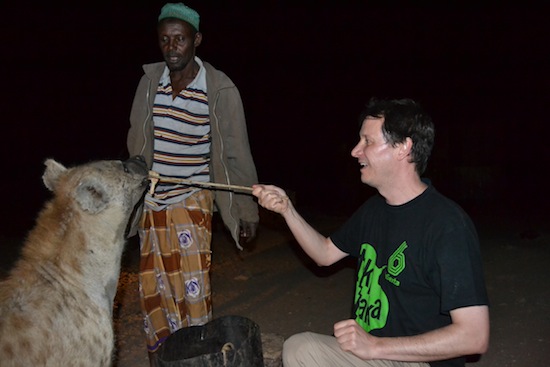
Yours truly feeding a hyena while Yusuf looks on
The first thing you learn if you spend any amount of time living in Harar is that it is not a human town. It is a human town during the day and a human and hyena town at night.
This medieval walled city in eastern Ethiopia has been a center of trade for centuries. Situated in a temperate climate between the central Ethiopian highlands and the Somali desert, it spent much of its history as an independent city-state. The Hararis have a distinct culture and language confined almost exclusively to the town within the walls. The surrounding countryside is dominated by the Oromo, who have their own language and culture.
The Harari and Oromo share space with another language and culture, that of the hyenas. Not seen much by day, they come out at night to scavenge food and wander the labyrinth of alleys that make up Jugol, the old city. Humans and hyenas have become accustomed to one another and have developed a unique and close relationship.
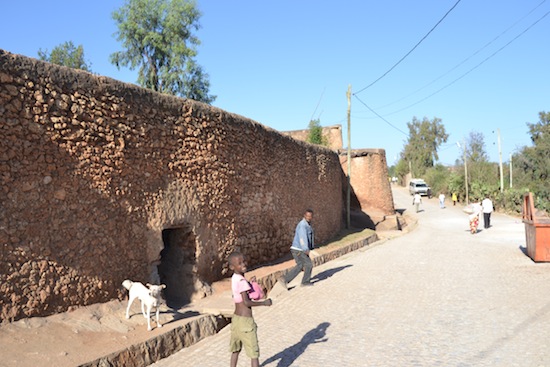
The wall around Jugol, the old city of Harar. The hole in the wall is not a gate, but rather a “hyena hole,”
one of several in the wall through which hyenas come and go. The larger ones also allow for the passage
of humans. Come nightfall, that dog will be barking its head off any time a hyena passes close by
That relationship is the subject of a new book by Australian anthropologist Marcus Baynes-Rock. Among the Bone Eaters: Encounters with Hyenas in Harar chronicles his dissertation research with a particular clan of hyenas. Marcus spent most nights with them, wandering the alleys of Jugol or the landfill where they hunted for scraps of food.
I first heard of Marcus when I first went to Harar in 2010 on my way to Somaliland. Everyone I met, both Harari and Oromo, was talking about the foreigner who walked with the hyenas at night. They all spoke in tones of amazement and respect. No one ever called him “weird” or “crazy” or even “a little bit odd”.
After spending a couple of weeks in Harar, it didn’t occur to me to think of him in those terms either. Hyenas were simply part of life. I saw them every night, crossing my path on the main roads or staring at me from the shadows with eyes glowing from the reflected light of my flashlight. Sometimes they brushed past me in the narrow alleys. The locals didn’t fear them so I didn’t fear them either.
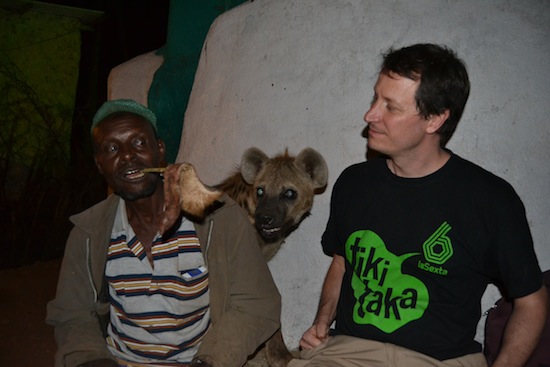
Tukwondilli reaching around Yusuf to grab a piece of meat. A moment later she jerked her
head and slapped me across the face with it. By the time I opened my eyes Yusuf was already offering me
some paper towels. I suspect I wasn’t the first person to get this treatment.
I didn’t meet Marcus until my second trip the following year, when I spent two months living in Jugol researching the region’s history and culture for a series of articles. Marcus started his evenings with Yusuf Mumey, locally known as “the hyena man”. This Oromo farmer lives just outside the Jugol walls and hands out strips of donkey meat to the local clan of hyenas, making some extra income from the tourists who come to watch this remarkable event.
Marcus had become quite close to Yusuf and his family, and his book gives us insight into both the culture of the Oromo in the countryside and the Hararis in the city. We also get to meet the hyenas of the Sofi clan, learning the idiosyncrasies of Baby and Kamareya, Fintamurey and Koti. Yusuf names most of them although Marcus came up with a few names too. We especially get to know Willi, who was the hyena Marcus grew closest to. Sometimes Marcus and Willi spent all night together, wandering in search of food and getting into tussles with the local dogs.
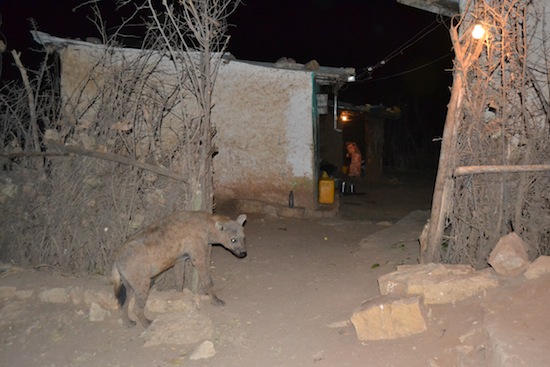
A hyena investigating the entrance to Yusuf’s compound
It’s fascinating to read how Marcus applied the anthropological technique of participant observation to work with wild animals. At the core of his research is the view that humans and animals have an interactive relationship that affects both species, unlike most anthropological research which views animals simply as resources used by people.
Marcus delves into the place hyenas have in Harari and Oromo culture, looking at how hyenas get rid of jinn and how some humans know hyena language. These special people will often find hyenas at their door, giving out their distinctive ooo-whoop! These are messages for those who can understand. Hyenas also serve the more practical purpose of garbage disposal. Once when I was going to visit some Oromo farmers in a village outside town, I found the road blocked by a sick camel. It lay there in a big heap, its chest rising and falling with ragged breaths like some dying sand dune. There was no need to clear this heavy animal out of the road, because by the next morning it would be nothing but a bloody patch in the dirt littered with a few well-gnawed bones.
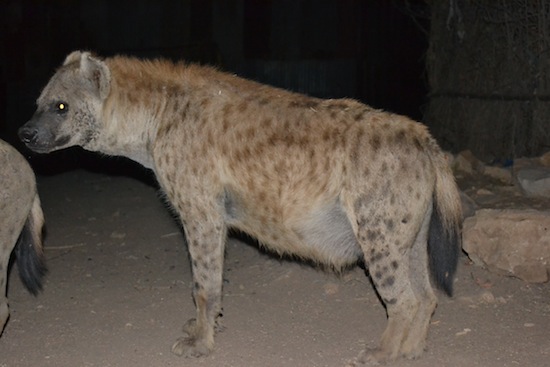
Koti, the dominant female of the Sofi clan. Marcus took this photo.
She wouldn’t have let a stranger like me this close.
Marcus also discusses the buda, who are people by day and hyenas by night. Buda tend to be thinner and paler than the average person. What some of the locals thought of this skinny white boy walking with the hyenas every night can easily be imagined. The buda also work in certain lower class trades such as blacksmiths. The blacksmiths of Harar could fill their own book. This ancient craft, being slowly killed off by cheap manufactured goods from China, is still alive in Harar. I hung out with blacksmiths at night several times and am sad to report I never saw one turn into a hyena.
Unlike the hyenas, the buda are feared and reviled. They ride hyenas at night looking for human victims. Sometimes they exhume corpses, reanimate them, and bring them home to use as personal servants. It’s odd that hyenas would be seen as generally useful, although needing to be treated with caution and respect, while these magical human-hyenas (Marcus doesn’t like the term “were-hyena”) are universally considered to be evil.
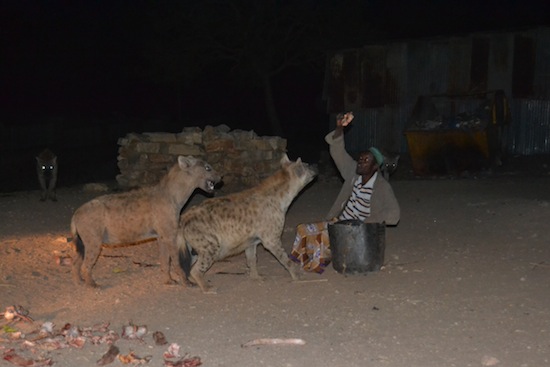
Koti and Hadha Kumar getting some dinner
There is so much more in this book that to summarize it would take almost a book in itself. As someone who has spent some time in Harar, it made me want to go back. Lots of familiar names and places appear in its pages, and anyone who is interested in visiting Ethiopia or simply interested in the interaction between humans and animals will get a lot out of this book. Marcus is now writing a book on Oromo horsemanship, something for which that culture is renowned.
Among the Bone Eaters: Encounters with Hyenas in Harar is like no other book you’ll ever read. If you’re looking for a well-written, absorbing account of one man’s immersion in both the culture of a different country and the culture of a different species, be sure to check it out.
All photos copyright Sean McLachlan except, of course, those in which I appear. Marcus took those. More below!
Sean McLachlan is the author of the historical fantasy novel A Fine Likeness, set in Civil War Missouri, and several other titles, including his post-apocalyptic series Toxic World that starts with the novel Radio Hope. His historical fantasy novella The Quintessence of Absence, was published by Black Gate. Find out more about him on his blog and Amazon author’s page.
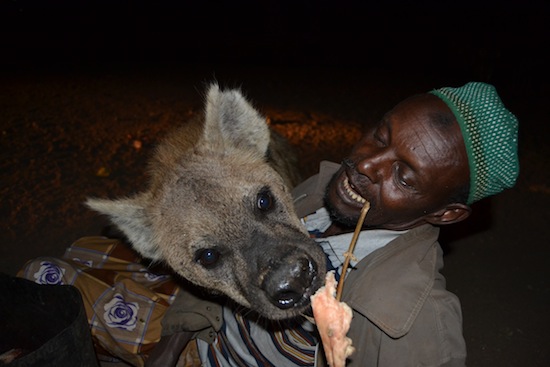
Yusuf getting up close and personal
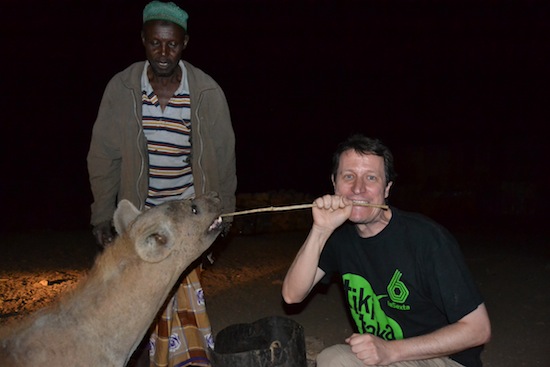
This is as close as I got. You gotta know your limits!
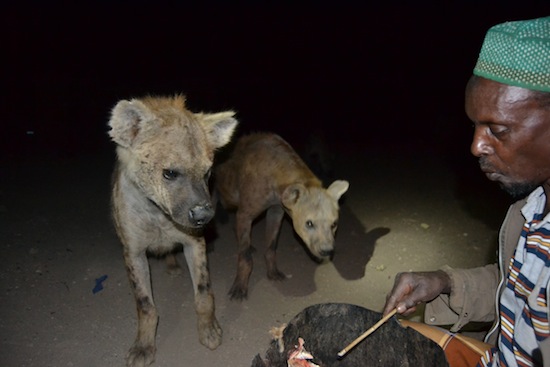

The Oromo market outside the Asmaddin Beri

One of the 99 mosques of Harar, corresponding to the 99 names of Allah


The mosque around the corner from my house. The hyenas usually disappeared shortly after the dawn call to prayer
Wow,
Now that’s an interesting article! Talk about “local culture” that could add zest to a historical/fantasy piece…
Thanks Sean!
Amazing photos!
This is one of the most story-feeding posts among your many, many story-feeding posts. Thank you!